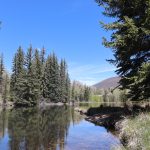Willoughby: From mining tram design to ski lift layout, a short schuss
Legends & Legacies

Courtesy Image
The Vulcan Wire Ropeway advertisement from 1892 illustrates something eerily familiar about a mining tram. If you glance at the image before reading the captions the similarity to a ski lift may seem even more pronounced. The major difference? The mining tram moves ore buckets, rather than chairs. The same companies that engineered and built mining trams also constructed the early ski lifts.
Four mining trams facilitated mining in Aspen. Soon after the advent of wire cable, the Aspen Public Tram, also known as the Tourtolotte Park Tram, and the Compromise Tram automated the movement of ore tonnage. Construction began in 1889 with completion the next year. The Tourtolotte tram ended approximately where the Silver Queen Gondola begins, and extended a similar length to Tourtolotte Park. The shortest tram, the Compromise, circulated just above the top of Little Nell.
Construction of the Montezuma Mine tram began in 1907 and lasted three years. The altitude — the top end of the basin reached above 13,000 feet — slowed progress. And deep winter snow limited construction to summers.
The last tram constructed, the Park Tram, transported ore from the top of Shadow Mountain ridge to the area around the Durant Condos. Constructed in 1922, it used cable from the American Steel and Wire Company and could move about 15 tons of ore per hour.
Lift One also contracted with American Steel and Wire for its cable. In 1946, Aspen Skiing Co. recycled wire from the Park tram to build Lift Two.
Mining trams increased mine profits. They replaced the expense and risk of transporting ore with horse-drawn wagons down Aspen Mountain roads. The less costly trams worked efficiently, high above accumulated snow, and mitigated winter’s challenges.
In addition to this column’s illustration, the 1892 Engineering and Mining Journal published three more ads for tram builders. An ad for California Wire Works of San Francisco used a patent by Andrew Hallidie. He had developed wire cable and the first San Francisco cable car. The Union Wire and Rope tramway Co. of New York featured John Roebling, the other wire cable inventor, who designed the Brooklyn Bridge. Trenton Iron Company of New Jersey boasted trams “from 100 yards to 12 miles” using the wire cable patents of Adolf Bleichert, a German engineer.
The Highland Bavarian partners planned and promoted their Aspen ski lifts during the 1930s. At the time, partner Tom Flynn wrote an article that explained the possibilities of trams as ski lifts. He noted that the Bleichert Co. had built 70 ski trams in Europe.
Flynn encountered no argument from Aspen’s ski enthusiasts. The Park Tram had operated when most of them were in their teens, and they had simply hopped an ore bucket to ride up the mountain. A ski tramway or chairlift simply required a switch from buckets to cable tramcars, or chairs. The Park Tram cable still snaked along the ground, ready for conversion to skiing pursuits.
Just before America entered World War II, Fred Willoughby, my grandfather, and D.R.C. Brown, newly elected president of the Aspen Ski Club, sketched out a tram. It would have reached from the bottom of Aspen mountain to the top of Roch Run. This would have resembled the original Lift One line, with the base a few hundred yards to the east.
The two men drew on the club’s experience building Aspen’s first lift, the boat tow. Rather than a chairlift, they envisioned a tram like those in Europe. They aimed to recycle local mining material, and create a frugal project the club could manage. The war snuffed out opportunity for their dream tram.
Tim Willoughby’s family story parallels Aspen’s. He began sharing folklore while teaching Aspen Country Day School and Colorado Mountain College. Now a tourist in his native town, he views it with historical perspective. Reach him at redmtn2@comcast.net.









